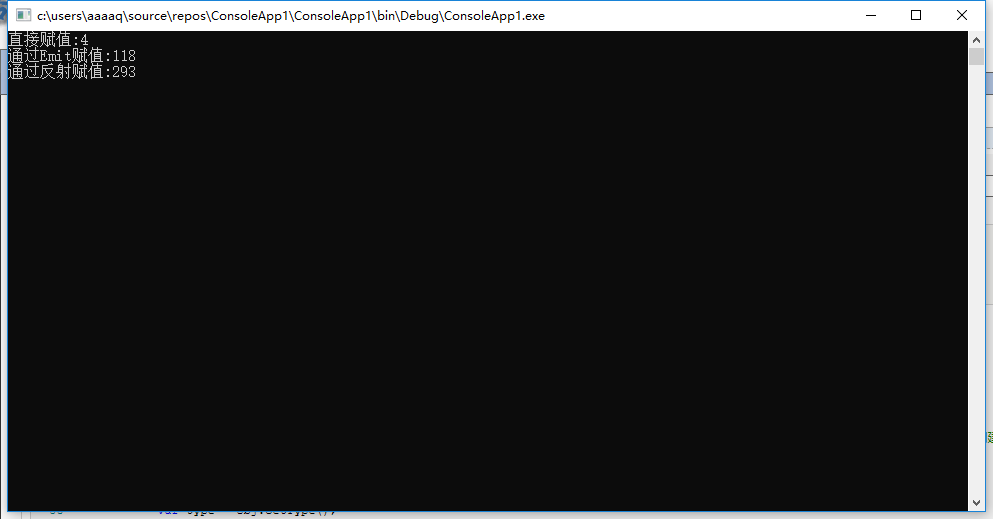1 public class Class1 2 { 3 public static void Button_Click() 4 { 5 TestDemoEntity entity; 6 Stopwatch watch; 7 int length = 1000000; 8 9 #region 直接赋值 1 10 watch = new Stopwatch(); 11 watch.Start(); 12 entity = new TestDemoEntity(); 13 for (int i = 0; i < length; i++) 14 { 15 entity.Name = "测试"; 16 } 17 watch.Start(); 18 Console.WriteLine("直接赋值:" + watch.ElapsedMilliseconds); 19 #endregion 20 21 #region 通过Emit赋值 2 22 watch = new Stopwatch(); 23 watch.Start(); 24 entity = new TestDemoEntity(); 25 var emitSetter = EmitSetter<TestDemoEntity>("Name"); 26 for (int i = 0; i < length; i++) 27 { 28 emitSetter(entity, "测试" + i); 29 } 30 watch.Start(); 31 Console.WriteLine("通过Emit赋值:" + watch.ElapsedMilliseconds); 32 33 #endregion 34 35 #region 通过反射赋值 3 36 watch = new Stopwatch(); 37 watch.Start(); 38 entity = new TestDemoEntity(); 39 for (int i = 0; i < length; i++) 40 { 41 ReflectSetter(entity, "Name", "测试"); 42 } 43 watch.Start(); 44 Console.WriteLine("通过反射赋值:" + watch.ElapsedMilliseconds); 45 46 #endregion 47 } 48 49 public static Action<T, object> EmitSetter<T>(string propertyName) 50 { 51 var type = typeof(T); 52 var dynamicMethod = new DynamicMethod("EmitCallable", null, new[] { type, typeof(object) }, type.Module);//定义和表示一个可以编译,执行和丢弃的动态方法 53 var iLGenerator = dynamicMethod.GetILGenerator();//返回方法的Microsoft中间语言(MSIL)生成器,默认的MSIL流大小为64字节 54 if (iLGenerator != null) 55 { 56 var callMethod = type.GetMethod("set_" + propertyName, BindingFlags.Instance | BindingFlags.IgnoreCase | BindingFlags.Public);//获取字段set属性 57 if (callMethod != null) 58 { 59 var parameterInfo = callMethod.GetParameters()[0]; 60 if (parameterInfo != null) 61 { 62 var local = iLGenerator.DeclareLocal(parameterInfo.ParameterType, true); 63 #region Emit()将指定的指令放在指令流上,该方法接收一个IL流。EmitCall()将 call 或 callvirt 指令置于 Microsoft 中间语言 (MSIL) 流,以调用varargs 方法。我们看到OpCodes类,该类描述中间语言 (IL) 指令 64 iLGenerator.Emit(OpCodes.Ldarg_1); 65 if (parameterInfo.ParameterType.IsValueType) 66 { 67 // 如果是值类型,拆箱 68 iLGenerator.Emit(OpCodes.Unbox_Any, parameterInfo.ParameterType); 69 } 70 else 71 { 72 // 如果是引用类型,转换 73 iLGenerator.Emit(OpCodes.Castclass, parameterInfo.ParameterType); 74 } 75 iLGenerator.Emit(OpCodes.Stloc, local);//OpCodes类,该类描述中间语言 (IL) 指令 76 iLGenerator.Emit(OpCodes.Ldarg_0);//将指定的指令放在指令流上,该方法接收一个IL流 77 iLGenerator.Emit(OpCodes.Ldloc, local); 78 iLGenerator.EmitCall(OpCodes.Callvirt, callMethod, null);//将 call 或 callvirt 指令置于 Microsoft 中间语言 (MSIL) 流,以调用varargs 方法 79 iLGenerator.Emit(OpCodes.Ret); 80 #endregion 81 } 82 } 83 } 84 return dynamicMethod.CreateDelegate(typeof(Action<T, object>)) as Action<T, object>;//CreateDelegate()完成动态方法并创建一个可用于执行它的委托。 85 } 86 public static void ReflectSetter(object obj, string propertyName, object propertyValue) 87 { 88 var type = obj.GetType(); 89 var propertyInfo = type.GetProperty(propertyName); 90 propertyInfo.SetValue(obj, propertyValue, null); 91 } 92 } 93 public class TestDemoEntity 94 { 95 public string Name { get; set; } 96 }
